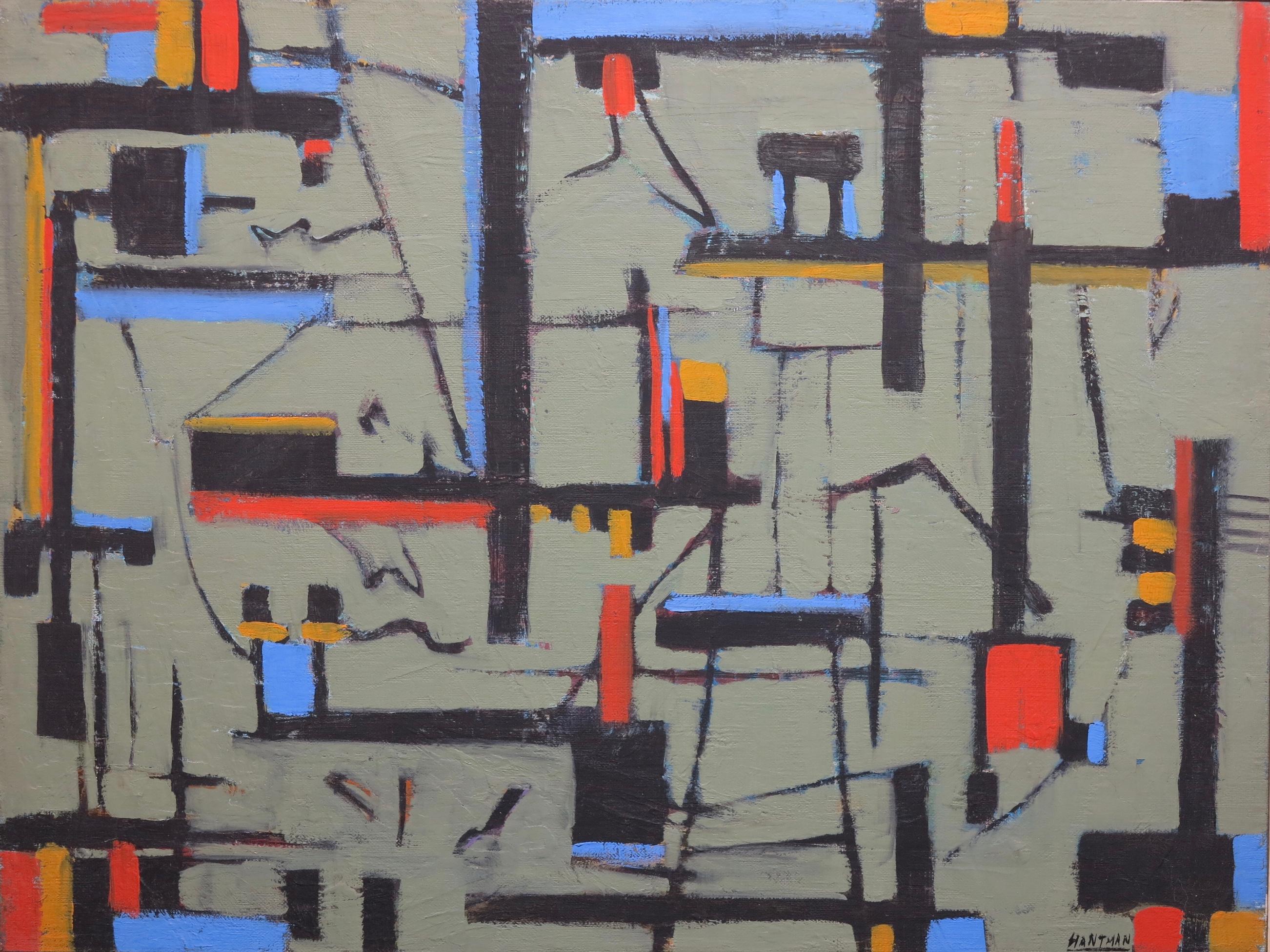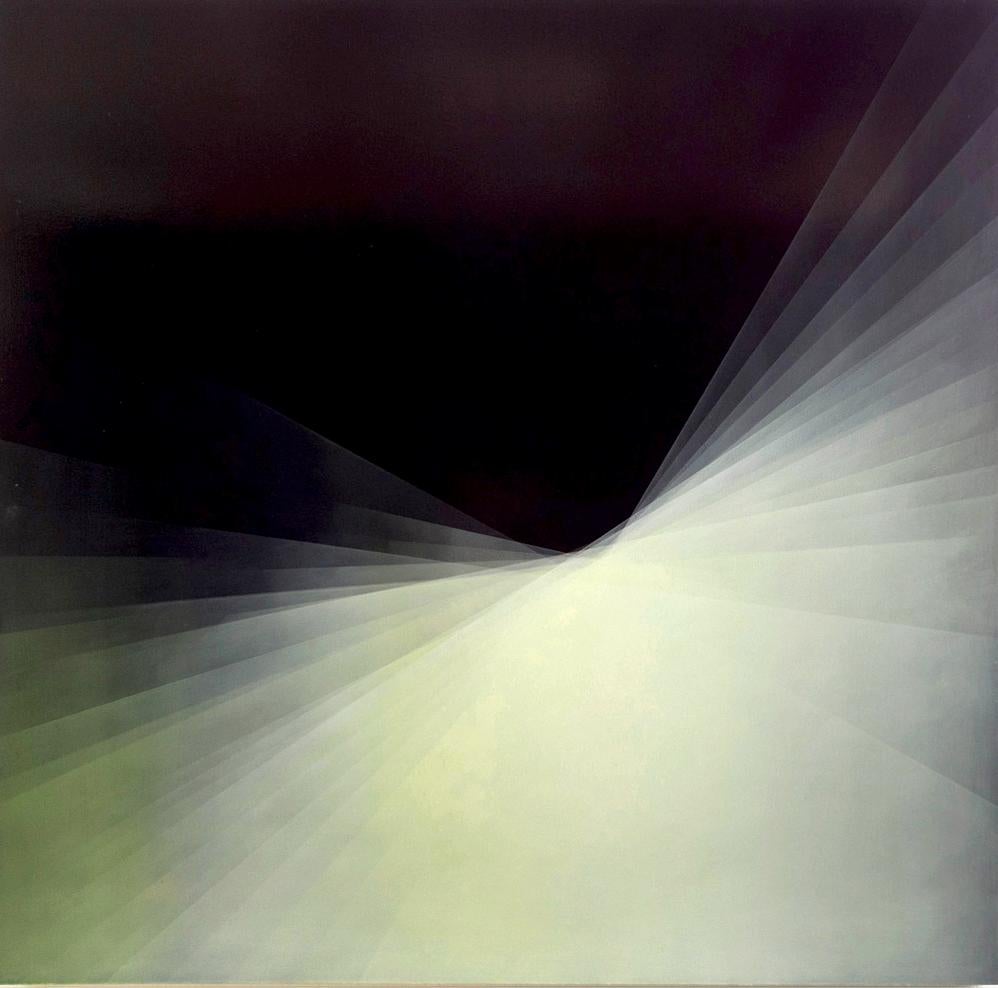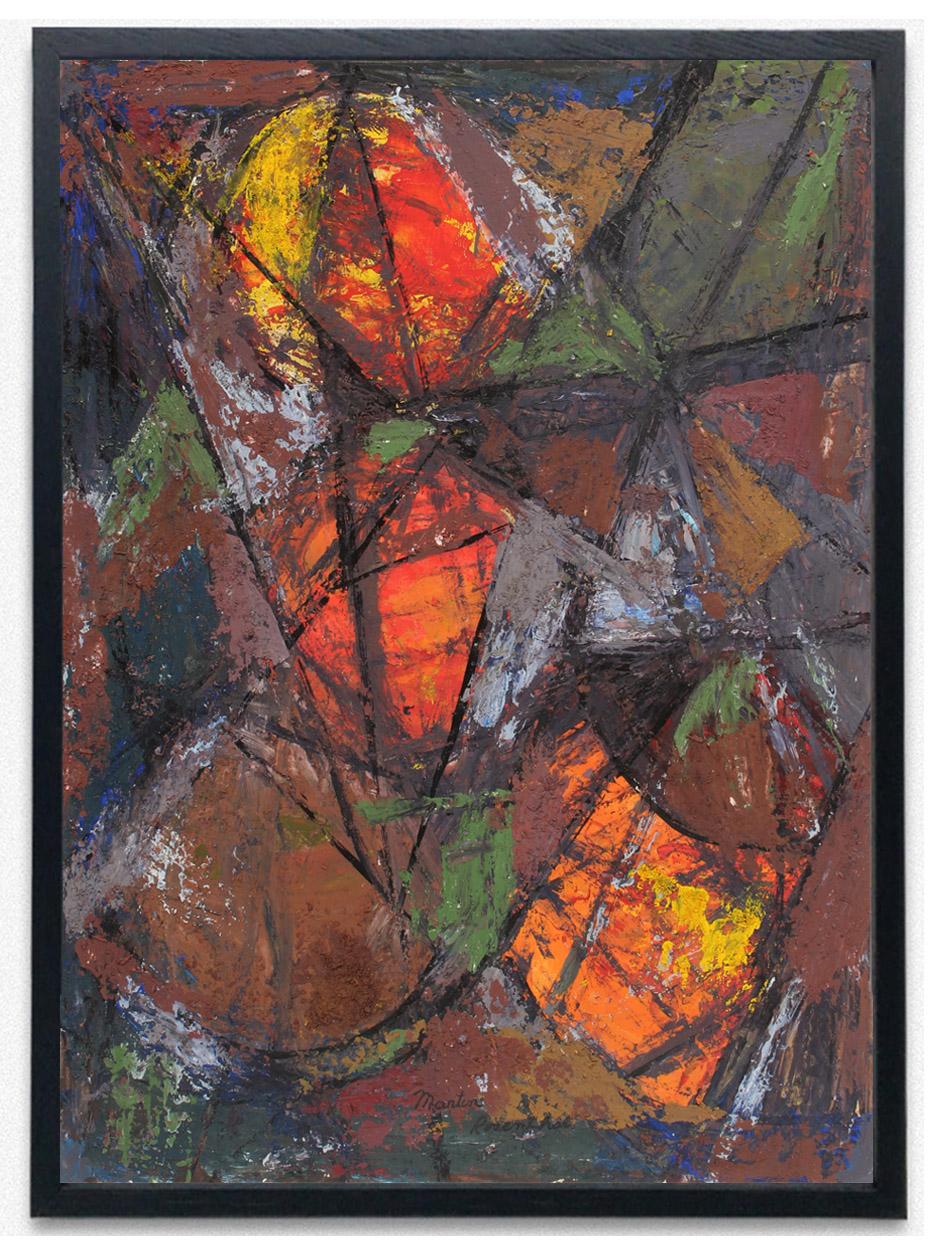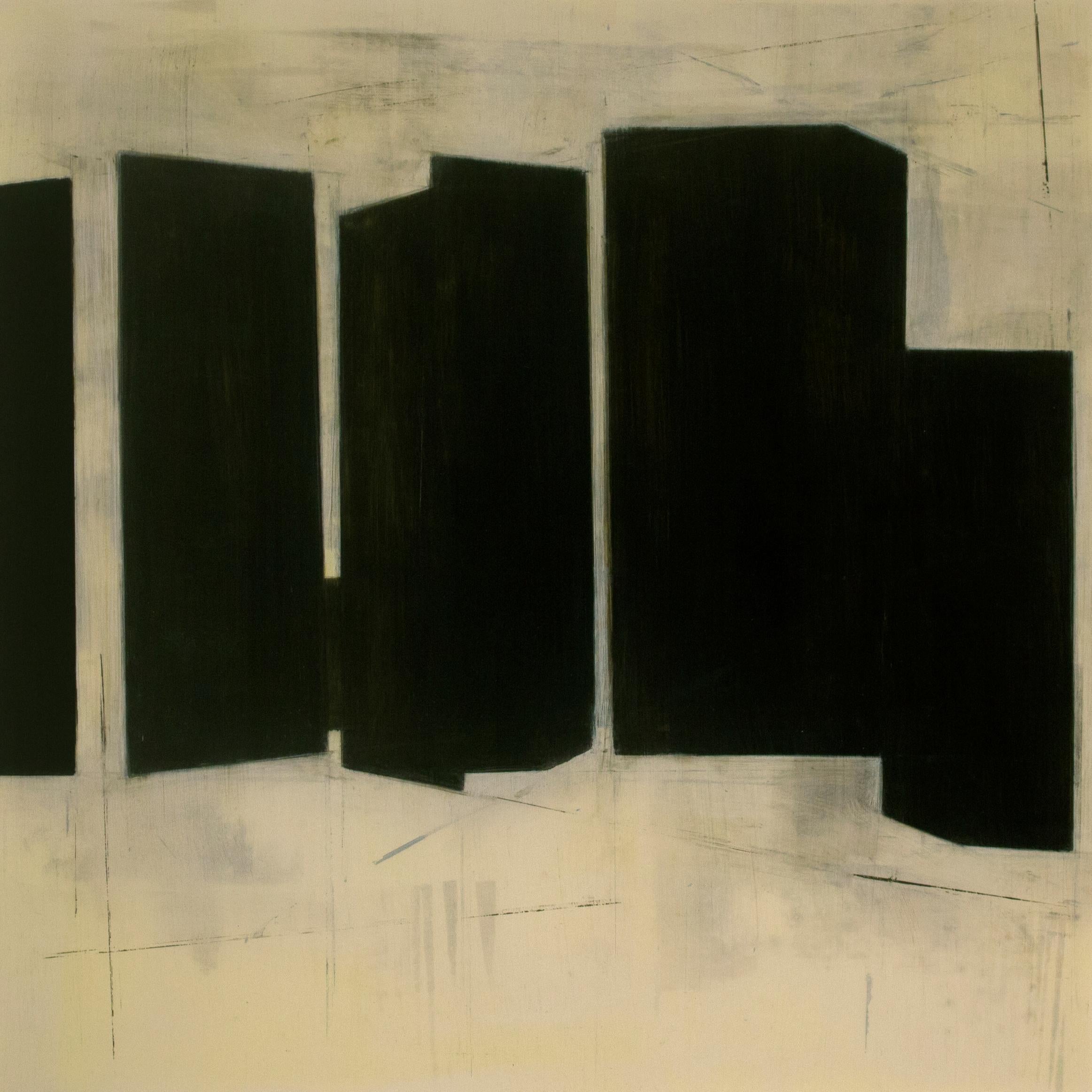Items Similar to Line Color Form Number 1
Want more images or videos?
Request additional images or videos from the seller
1 of 12
Albert ManchakLine Color Form Number 11959
1959
About the Item
Line, Color, Form Number 1, 1959, by Albert Manchak (b. 1925)
Oil on canvas
35 ½ x 35 ½ inches unframed
37 x 37 inches framed
Signed on bottom right
Labeled (ALBERT MANCHAK Line, Color, Form Number 1 Geometric Abstraction in America March 21-May 13 1962) on reverse
Inscribed (Line, Color, Form #1) on reverse top
Label (Artist) on reverse top
Description:
Albert Manchak was part of a revolutionary movement of Geometric Abstractionists in the early to mid-nineteenth century. Inspired by Cubism, this form of abstraction prioritized simple shapes, such as rectangles and triangles, for the purpose of creating an architectural composition that didn’t reference subject matter. In this pursuit of this simplicity, Manchak found that by compartmentalizing his canvas through this use of shapes and primary colors, he was brought closer to the natural world and its “ultimate reality.” This work by Manchak was exhibited at the Whitney Museum of American Art.
This oil painting by Albert Manchak expertly uses line, color, and form to create a simplified, though not simple, image. Manchak uses the primary colors, white, and black to structure the work as a rejection of complex color and variation. His use of two distinct line weights-- fine and bold-- creates a binary between which the work oscillates. Finally, Manchak focuses on rectangles and rectangular shapes, only using 90-degree angles to divide up the canvas into segments, further simplifying the canvas into the use of one shape. Through these visual forms, Manchak recalls a simplicity lost in the pursuit of complex renderings of objects and reality. With no focus on recognizable forms, Manchak only renders the elements of such forms into a distinct and complete artwork.
- Creator:Albert Manchak (1925 - 2014, American)
- Creation Year:1959
- Dimensions:Height: 35.5 in (90.17 cm)Width: 35.5 in (90.17 cm)
- Medium:
- Movement & Style:
- Period:
- Condition:
- Gallery Location:New York, NY
- Reference Number:1stDibs: LU163728824502
About the Seller
5.0
Vetted Seller
These experienced sellers undergo a comprehensive evaluation by our team of in-house experts.
Established in 1948
1stDibs seller since 2021
7 sales on 1stDibs
Typical response time: 2 hours
- ShippingRetrieving quote...Ships From: New York, NY
- Return PolicyA return for this item may be initiated within 14 days of delivery.
More From This SellerView All
- Dark ImageBy Will BarnetLocated in New York, NYDark Image, 1960 by Will Barnet (1911-2012) Oil on canvas 53 x 30 ½ inches unframed (134.62 x 77.47 cm) 55 ½ x 32 ⅞ inches framed (140.979 x 96.2152 cm) Signed and dated on top right on the reverse Description: This abstract oil painting by Will Barnet uses minute gradations in value to achieve a work that presents a contextual understanding of color. Upon first inspection, it looks as if Barnet has created a completely black canvas with some hints at forms in the darkness; however, upon a closer look, the canvas is, in fact, not black, but instead comprised of varied shades of dark, muted blues, grays, and purples. Barnet presents us with an illusion of vision, asking the viewer to question his perspective and understanding of color interplay. At the beginning of his career, Will Barnet was known for his figural depictions of domestic scenes. But, as he continued to stylistically develop, Barnet arrived at abstract geometric paintings far removed from his original career. A part of the Indian Space...Category
1960s Abstract Abstract Paintings
MaterialsOil
- Burning Bush from Jerusalem SeriesBy Theodoros StamosLocated in New York, NYBurning Bush, 1989, by Theodoros Stamos (1922-1987) Acrylic on canvas 66 x 50 inches unframed (167.64 x 127 cm) Inscribed (Infinity Field Jerusalem Series...Category
Late 20th Century Abstract Expressionist Abstract Paintings
MaterialsAcrylic
- Infinity Field T Series 2 128By Theodoros StamosLocated in New York, NYInfinity Field T Series #2, 128, 1992 by Theodoros Stamos (1922-1997) Acrylic on canvas 64 x 50 inches unframed (162.56 x 127 cm) Inscribed (INFINITY ...Category
Late 20th Century Abstract Expressionist Abstract Paintings
MaterialsAcrylic
- Bath Apollo Series "Blue Gaze"By Robert NatkinLocated in New York, NYBlue Gaze, 1977, by Robert Natkin (1930-2010) Acrylic on canvas 66 x 66 inches framed 25.98 x 25.98 cm) Signed on bottom right Exhibitions: In 1957, Momentum, Chicago, IL In 1968, Pointdexter Gallery, New York, NY (solo) In 1969, San Francisco Museum of Art (retrospective 1952-1969), San Francisco, CA (solo) In 1974, Within the Decade: Selections from the Guggenheim Museum Permanent Collection, The Solomon R. Guggenheim Museum, New York, NY In 1980, Masters of American Watercolor, The Oklahoma Art Center, Oklahoma City, OK In 1992, Gimpel Fils Gallery, London, UK (solo) In 2007, LewAllen Contemporary, Santa Fe...Category
1960s Abstract Expressionist Abstract Paintings
MaterialsCanvas, Acrylic
- CurtainBy Stanley William HayterLocated in New York, NYCurtain, 1975, by Stanley William Hayter (1901-1988) Oil on canvas 25 x 19 inches unframed (63.5 x 48.26 cm) 26 ¼ x 20 ⅜ inches framed (66.675 x 51.753 cm) Signed and dated on bottom...Category
20th Century Abstract Expressionist Abstract Paintings
MaterialsAcrylic
- RowsBy Julian StanczakLocated in New York, NYRows, 1970, by Julian Stanczak (1928-2017) Acrylic on canvas 27 ¼ x 27 ¼ inches unframed (69.215 x 69.215 cm) 28 ½ x 28 ½ inches framed (72.39 x 72.39 cm) Signed on reverse Dated and...Category
Late 20th Century Op Art Abstract Paintings
MaterialsAcrylic
You May Also Like
- Industrial CompositionBy Murray HantmanLocated in Wilton Manors, FLMurray Hantman (1904-1999). Industrial Composition, c.1948-50. Oil on canvas measures 18 x 24 inches, 19 x 25 inches in original simple wood strip frame. Signed lower right. Excellent condition with no conservation. Exhibition label affixed en verso. Provenance: estate of Murray Hantman. This piece was included in the exhibition Murray Hantman: From Image to Abstraction, Portland Museum of Art, 2005. Anonymous lender. Biography: Shaped by his life experiences and a commitment to the practice of making art, the work of Murray Hantman represents a career of personal exploration and aesthetic refinement that took him from New York, to Los Angeles, back to New York and eventually to the serene, yet dramatic, coast of Maine where he worked as part of the artists’ colony on Monhegan Island. Born in Pennsylvania in 1904, Hantman’s family moved many times to follow his father’s business opportunities, eventually settling in New York. A childhood of economic instability and dislocation formed Hantman’s early years, making him independent and self-reliant from a very early age. Hantman’s father owned movie theatres and photography studios and, recognizing his son’s artistic ability, employed him to print and hand-color photographs as a child. When he was eleven and living in Michigan, a public school teacher arranged for Hantman to receive a scholarship to the Detroit Museum of Art School where after a year he was awarded another scholarship to study at the Detroit School of Design. He studied in Detroit for a year until his family abruptly moved to Alabama, interrupting his artistic and academic studies until the family moved to New York at the end of the first World War. As a young man, Hantman supported himself by working many different jobs in New York and New Jersey. Steady work with his brother at the Hartford and New Haven Railroad office in New York City finally allowed Hantman to pursue his artistic studies in a formal way. In 1928, he enrolled in the Art Students League and became part of a social circle of artists and activists. While at the Art Students League, Hantman worked with faculty members Boardman Robinson and Thomas Hart Benton on two mural projects. During the years around the Great Depression, Hantman worked in Los Angeles with a group of artists known as the Bloc of Painters. Recruited through an advertisement to attend a course on fresco painting, the Bloc group was headed by Mexican muralist David Alfaro Siqueiros who had recently been exiled from Mexico for political activism. Through his work with Siqueiros, Hantman became motivated by social and political issues and their creative expression. In 1934, Hantman returned to New York and found the community of artists there equally engaged in social justice issues. While enrolling at the newly-formed Artists’ Union to advocate for the labor rights of creative workers, Hantman met sculptor Jo Levy who would become his wife. Like many artists at the time, Hantman found work through the Federal Art Project as a member of the Easel Painting Division which strove to create “works of art for the public which have a definite social value to the community”. (1) Along with the work he exhibited as a member of the WPA group, Hantman’s personal work from this period was in the style of Social Realism he learned from Siqueiros. Hantman and his wife, Jo Levy, believed in creating art for the public good. Their Artists’ Union friends and colleagues from the Federal Art Project formed the nucleus of their social circle and would become the community of artists who worked together during summers on Monhegan Island off the coast of Maine. In 1945, Hantman had his first solo painting show at Marquie Gallery in New York, and visits Monhegan Island for the first time. The following summer, he and Levy spend the summer in Maine, and would continue to do so for the next thirty years. The landscapes and seascapes of Maine would become a central subject in his work after 1946. The dramatic coastline of Monhegan Island had been inspiration for other New York artists before Hantman, including George Bellows and Rockwell Kent. As Hantman matured as an artist he began to reject academic narrative in his work, moving towards a more expressionistic and abstract style. During this shift into abstraction, nature remained central to his work and the seascape and Maine light provided continual inspiration. In the late 1940s, Hantman begins to reduce the landscape into elemental forms of color and shape. As he pursues this mode of painting his work moves further into abstraction, juxtaposing large blocks of saturated color to convey the drama of sea and sky. Always a student and teacher, Hantman distilled the ideologies of Abstract Expressionism and synthesized its concepts into his own work. Throughout the 1950s, he experimented with Action Painting, color, form and expression. By the late 1950s, Hantman’s mature style had developed into abstract works of pure color masses in simple geometric forms. His mastery of color and form continued into his late work, always reflecting the beauty of the natural world around him. Dedicated to the idea of exploration in his art, Hantman made hundreds of small color and form studies that hint at the large-scale works that would follow in the late 1960s and beyond. Hantman’s work from the ‘70s and ‘80s shows even more intensity of color and distillation of composition. The landscape of the Maine coast remained his muse throughout, the stark lines suggesting the flat plane of sea and horizon line beyond. Hantman and Jo Levy lived in New York and summered on Monhegan Island until 1975, followed by summers in Owls Head and New Harbor...Category
Mid-20th Century Abstract Geometric Abstract Paintings
MaterialsCanvas, Oil
- VortexBy Michael ConradsLocated in Torino, TOThe work is a mixed media on canvas, with watercolor, acrylics, oil, spray paint, 160x160 cmCategory
2010s Abstract Geometric Abstract Paintings
MaterialsOil, Spray Paint, Acrylic, Watercolor
- Refraction Aubergine by Bernadette Jiyong Frank - Contemporary abstract paintingBy Bernadette Jiyong FrankLocated in DEAt the heart of each of Frank’s paintings is the Japanese concept of Ma, which is the space or pause between events, moments, forms, and thoughts. It can be felt, for example, at the...Category
21st Century and Contemporary Abstract Geometric Abstract Paintings
MaterialsResin, Oil
- Abstract American Geometric Oil Painting Martin Rosenthal 60 Mid Century ModernBy Martin RosenthalLocated in Buffalo, NYAn original abstract oil painting by American artist Martin Rosenthal signed by the artist and created in the late 1950's, early 1960's. This colorful dynamic work comes housed in a...Category
1960s Abstract Geometric Abstract Paintings
MaterialsPaper, Oil
- Steven Baris, Chunkchain A7, 2019, oil on mylar, 14 x 14 inchesBy Steven BarisLocated in Darien, CTOver the past few years Steven Baris Has been fascinated by the rapid proliferation of fulfillment and distribution centers, sprouting like mushrooms throughout metropolitan regions....Category
2010s Abstract Geometric Abstract Paintings
MaterialsMylar, Oil
- Steven Baris, Chunkchain A6, 2019, oil on mylar, 14 x 14 inchesBy Steven BarisLocated in Darien, CTOver the past few years Steven Baris Has been fascinated by the rapid proliferation of fulfillment and distribution centers, sprouting like mushrooms throughout metropolitan regions....Category
2010s Abstract Geometric Abstract Paintings
MaterialsMylar, Oil
Recently Viewed
View AllMore Ways To Browse
Number 1
Number 13
Vintage Color Forms
Bottom Line
Retro Primary Colors
Rectangle Vintage Frames
Art Primary Colors Mid Century
Vintage Architectural Rendering
Vintage Architectural Renderings
Retro Architectural Renderings
Mid Century Architecture Rendering
Albert Manchak
French Rococo 17th Century
Screens For Outdoor
Black And White 1970s Abstract Painting
Abstract Blue Green Brown Paper
Dining Table 8 Person
Rufino Tamayo Signed





